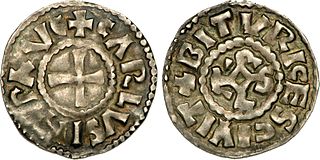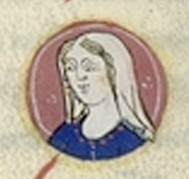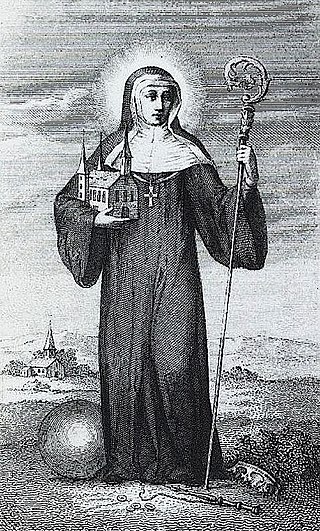Related Research Articles

Year 741 (DCCXLI) was a common year starting on Sunday of the Julian calendar. The denomination 741 for this year has been used since the early medieval period, when the Anno Domini calendar era became the prevalent method in Europe for naming years.

Year 783 (DCCLXXXIII) was a common year starting on Wednesday of the Julian calendar. The denomination 783 for this year has been used since the early medieval period, when the Anno Domini calendar era became the prevalent method in Europe for naming years.

Year 721 (DCCXXI) was a common year starting on Wednesday of the Julian calendar. The denomination 721 for this year has been used since the early medieval period, when the Anno Domini calendar era became the prevalent method in Europe for naming years.

Charles III, called the Simple or the Straightforward, was the king of West Francia from 898 until 922 and the king of Lotharingia from 911 until 919–923. He was a member of the Carolingian dynasty.

Carloman I, also Karlmann, was king of the Franks from 768 until he died in 771. He was the second surviving son of Pepin the Short and Bertrada of Laon and was a younger brother of Charlemagne. His death allowed Charlemagne to take all of Francia and begin his expansion into other kingdoms.

Willibrord was an Anglo-Saxon missionary and saint, known as the "Apostle to the Frisians" in the modern Netherlands. He became the first Bishop of Utrecht and died at Echternach, Luxembourg.

Bertrada of Laon, also known as Bertrada the Younger or Bertha Broadfoot, was a Frankish queen. She was the wife of Pepin the Short and the mother of Charlemagne, Carloman and Gisela, plus five other children.

Prüm Abbey is a former Benedictine abbey in Prüm, now in the diocese of Trier (Germany), founded by the Frankish widow Bertrada the elder and her son Charibert, Count of Laon, in 721. The first abbot was Angloardus.

Pepin the Short, was King of the Franks from 751 until his death in 768. He was the first Carolingian to become king.
Charibert, Count of Laon, was the maternal grandfather of Charlemagne. Charibert was the father of Charlemagne's mother, Bertrada of Laon.

Plectrude was the consort of Pepin of Herstal, the mayor of the palace and duke of the Franks, from about 670. She was the daughter of Hugobert, seneschal of Clovis IV, and Irmina of Oeren. She was the regent of Neustria during the minority of her grandson Theudoald from 714 until 718.

Bertrada, also called Berthe or Bertree, is known to be the mother of Charibert of Laon, with whom she is co-founder and benefactor of the Prüm Abbey. They founded the abbey in 721.
Bertrade (French) or Bertrada (Latin) is a feminine given name derived from Proto-Germanic roots reconstructed as *berht ("bright") and *rād.

Saint Leudwinus, Count of Treves founded an abbey in Mettlach. He was Archbishop of Treves and Laon. As patron saint of the Mettlach parish, his relics are carried through the town by procession at the annual Pentecost celebration. His feast day is September 23. He was the son of Saint Warinus, the paternal grandson of Saint Sigrada, and nephew of Saint Leodegarius.
The Robertians are the proposed Frankish family which was ancestral to the Capetian dynasty, and thus to the royal families of France and of many other countries. The Capetians appear first in the records as powerful nobles serving under the Carolingian dynasty of Charlemagne in West Francia, which later became France. As their power increased, they came into conflict with the older royal family and attained the crown several times before the eventual start of the continuous rule of the descendants of Hugh Capet.

Irmina of Oeren was a saint, founder and abbess of a convent in Oeren, near Trier (Trèves), and co-founder of a convent in Echternach. Hagiographer Basil Watkins states that Irmina's 12th century biography is "unreliable" and it is likely that "legends about her family tree spiralled out of control", but she came from one of the most powerful families in the Merovingian kingdom. She might have been Saint Primina, the daughter of Dagobert I and sister of Saint Modesta. She might have been the daughter of Dagobert II and sister of Saint Adela of Pfalze. Historian Ian Wood stated that Irmina is "traditionally, and probably correctly, identified as Plectrude's mother".
Rotrude (Chrodtrudis) (or Crotude, Chrotrude, or Ruadtrud; died 724) was the first wife of Charles Martel, Mayor of the Palace and de facto ruler of Francia from 718 to 741. She was the mother of Pepin the Short, King of the Franks, and therefore the grandmother of Charlemagne. Rotrude is believed to be the daughter of Lambert, Count of Hesbaye, although this designation is not without controversy, as discussed below. She is also referred to as Rotrude of Treves.
Hardrad was a Frankish count and a leading figure in the conspiracy of Thuringian noblemen against Charlemagne. This conspiracy resulted in many nobles being killed and their property confiscated, leading to the laws concerning the subdued Saxons established in the Diet of Aix of 802-803. Hardrad was a member of the Eastern Frankish aristocracy with extensive land assets and good relations with the Monastery of Fulda, and was likely related to the abbot, Baugulf von Fulda. Little is known about the life of Count Hardrad, even from contemporary Frankish sources. In 771, the Cartulary of Lorraine, Abbey Gorze, identified a deceased Hardrad, father of Ratard, who could have been the father or grandfather of the younger Hardrad. It is the same with two other occurrences, one of which is in 746 in Echternach and the other in 721 in Prüm, in which Bertrada of Laon and her father Charibert, the maternal grandfather of Charlemagne, are mentioned.
Chrodbert was a nobleman from Neustria. He was grandson to Chrodbert I, referendary to Clovis II through Chrodbert's son Lambert of Hesbaye. Chrodbert was Lord Chancellor during the reign of Chlothar III, King of the Franks in Neustria, as well as referendary. He was a contemporary of Ansbert of Rouen, who was also a Lord Chancellor to Clotaire III. Chrodbert was mentioned as Count palatine on 2 October 678.

Louis IV, called d'Outremer or Transmarinus, reigned as King of West Francia from 936 to 954. A member of the Carolingian dynasty, he was the only son of king Charles the Simple and his second wife Eadgifu of Wessex, daughter of King Edward the Elder of Wessex. His reign is mostly known thanks to the Annals of Flodoard and the later Historiae of Richerus.